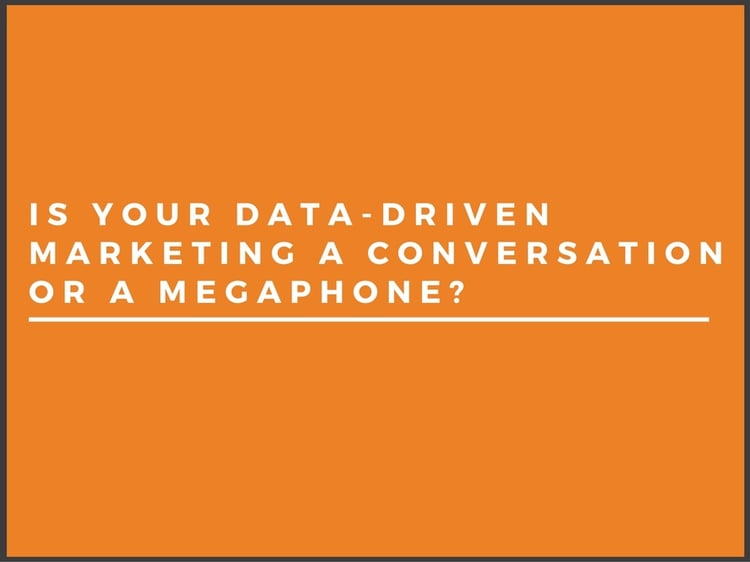In the fast-paced world of e-commerce, one of the greatest challenges marketers face is dealing with cart abandoners. These are the customers who browse your online...

The use of data to track individual consumers and market directly to them solves many of the problems posed by the broad-stroke marketing tactics of yesteryear. However, although the constructive application of data is generally a good thing, it’s not hard for businesses to use this information in a way that alienates consumers instead of attracting them.
Businesses are happy to collect data about their customers, as they should be. But those businesses also have to give something back to consumers. A Microsoft study shows that consumers are very willing to share their personal data with businesses — as long as they get something of value in return. In other words, the data provided by consumers must be compensated for in the form of rewards and individualized attention that proves the company really understands these consumers as individuals.
All companies are eager to assume that they know what their audience wants. The truth is, there’s no real way to know without consumer data. If you use that data to build a marketing megaphone instead of a conversation, you’ll risk losing your audience to a company who has taken the time to deliver the individualized marketing they deserve and expect.
Marketing Megaphones Are All About “Me”
One of the best parts about the new wave of data-driven marketing is that it’s a drastic departure from megaphone marketing — you know, the marketing that talks only about the company and their wants. Think about the last marketing email or direct mail piece you received that produced an intense reaction against the brand who sent it. Was it because the company not only didn’t take the time to talk to you as an individual, but that their messaging came across as braggadocio to the point of being untrustworthy? When an organization uses their marketing to shout all their good qualities and the reasons why they are the perfect solution for a consumer’s problem, they risk losing not only their audience’s attention but their trust.
That’s the problem when data is used as a megaphone: you can know who your customers are, what they want, and where they are on their customers journey, but you won’t be engaging them with meaningful marketing because you’re too busy talking about yourself.
Good Conversations Start with Listening — To Intent Data
The opposite of megaphone marketing is a company that listens and directly applies data insights into their marketing and the customer experience as a whole. Fewer than 40 percent of businesses see significant gains as a result of utilizing data, while 87 percent of marketers consider data to be their most underutilized asset. There’s clear potential for the use of data as a powerful marketing tool. Why, then, are so many companies having trouble putting it to work for them?
One issue is that companies don’t always act on the right data points. Knowing a given customer likes hiking is all well and good, but it doesn’t really mean anything until that customer who likes hiking is ready to make a hiking-related purchase. And even then, if the company is ill-equipped to respond in a timely fashion, this information has diminished value. The best way to identify people on the cusp of buying, and to be ready for those purchases, is by listening to intent data.
As the name suggests, intent data is information that comes as a direct result of purchase-based behaviors, such as reaching out to customer support or frequently visiting a specific product page on your website. Unlike the idea of megaphone marketing, intent data begins with the most important people in the equation — the consumers. It’s only when businesses listen to intent data that they know what motivates consumers to act.
This idea of listening to your audience is vital. Individuals who’ve visited your website and exhibited intent don’t need megaphone-type messages about the virtues of your company. They already know who you are and what you do. What they don’t know are the answers to the questions they’re subconsciously asking through their intent data, but through understanding intent data, you’ll be able to gain actionable insights into their consumer behavior so you can provide them with the answers or solutions they are searching for.
Continuing the Conversation with More Data
But how do you go from listening to engaging in a conversation?
Virtually anyone who has ever looked at products online can recall an instance of data-based megaphone marketing gone wrong. For instance, you’re in the market for a new yoga mat, so you do some online browsing for different options, colors and price points. Your reward for your search is a bombardment of banner ads for yoga mats from each site you visited for weeks to come. No rewards, no promo codes, no information to help you make the best choice in yoga mats...nothing of any value for you. Just non-stop annoyance that continues whether or not you’ve already made a purchase. In the end, you turn against these businesses that just won’t leave you alone.
This type of marketing doesn’t just annoy people. It can spoil gifts they’ve bought for their family members (which does far more harm than any potential good the ad might do). This isn’t the ideal solution for data-driven marketing, and yet marketers continue to execute this exact strategy.
There’s a better way to incorporate data into a marketing scheme that doesn’t endlessly assault your customers with things they already know. Using the example of the yoga mat, you can use the consumer’s search for a yoga mat as just one portion of an overall consumer profile. This single customer view allows you see many other attributes, past purchase behavior and current interests that can help you suggest other items that may actually interest this customer. Our customer who searched for yoga mats also subscribed to Self magazine two months ago and ordered an introductory yoga DVD from your company. Your conversation with this customer begins by showing her digital display ads for a yoga brick or yoga pants that you think she may also be interested in based on her lifestyle. You could also send her tips on how healthy eating and exercise combined produce better results. When she responds by visiting a product page or not, you’ll have more information on how you can continue to build a conversation she wants to participate in.
Develop the Art of Conversation with Data
Today’s data landscape allows you to obtain a tremendous amount of information about everyone that visits your site. You can also find out the locations, demographics, interests and purchase histories of people who frequent your website, allowing you to create a single view for each customer you encounter. Using intent data lets you draw on these findings in real time, enabling you to begin a conversation tailored to an individual’s needs and wants in the moment. The possibilities and combinations you can use to reach your audience are endless — as long as you use data in a way that truly benefits the consumer first.

